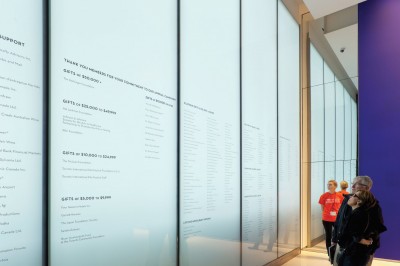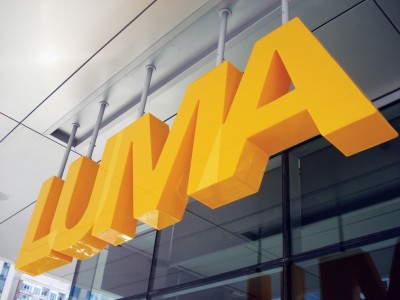Placement, size and colours were all specified to integrate effectively into the space. To emphasize which floor visitors are reaching as they move through the building, for example, oversized numbers are recessed into the drywall at the top and bottom of the escalators, painted out to match the wall backgrounds.
Each of the five cinemas is identified with a 650-mm (25-in.) high brushed aluminum channel number, accompanied by a sign box mounted adjacent to the entrance, housing a 1-m (40-in.) liquid crystal display (LCD) that features updated program information. The front panel is hinged to the box for easy access to the screen, in case repairs are needed.

The main donor recognition wall is made of translucent white glass with diffuser panels behind it. A ‘searchlight’ effect gradually highlights all of the names. Photo by Tom Arban
Further LCDs of various sizes are installed to serve as digital signage near the elevators and box office. A six-screen cluster in the main lobby informs visitors about what’s on.
All of the interior signs were manufactured and installed by Marvel Sign & Display, based in nearby Vaughan, Ont.
Craft services
As mentioned, the facility includes two restaurants. Canteen serves bistro fare on the ground level, while Luma provides fine dining on the second floor. Acumen Visual Group in Markham, Ont., manufactured vinyl graphic applications of both restaurants’ logos, as well as an internally illuminated sign identifying Luma on the building’s second-floor balcony.
O&B also operates an event space, Malaparte, on the sixth floor. Its logo uses a stylized image of an iconic staircase leading to the roof of Villa Malaparte in the Jean-Luc Godard film Contempt, which starred Brigitte Bardot. G+A designed the identities and signage elements for the restaurants and the event space.
The filmmakers would like to thank . . .
An organization like TIFF cannot function without generous outside support. Indeed, nearly 40 per cent of TIFF’s operating revenues come from philanthropic donations and private-sector sponsorships. As such, donor recognition is another substantial purpose of the signage program for the building.

An internally illuminated sign identifies the Luma restaurant on the building’s second-floor balcony. Photos courtesy Entro | G+A
The main donor recognition wall is a 3.8 x 1.7 (12.4 x 5.6-ft) structure of white translucent glass with diffuser panels behind it. These panels help soften the rough pattern created by a low-pixel-pitch LED-based video wall—supplied by Trans-Lux Canada in Burlington, Ont.—that uses an animated searchlight effect to gradually highlight all of the donor names. This motion also helps bring attention to the donor wall in the first place.
In addition to this donor recognition wall positioned in a key location, two more can be found at the second- and third-floor landings, showcasing names organized on the basis of different donation levels. These names are applied as custom-coloured vinyl letters on the first surface of the building’s frosted curtain wall. Natural light illuminates them by day, while an LED band provides additional contrast at night.
There are also many donor-named spaces throughout the building. These are identified with either brushed aluminum dimensional letters or vinyl appliqués.
World premiere
Given the image-based culture it reflects, TIFF’s brand is highly visually expressive through a variety of print- and web-based media. The opening of its dedicated facility has allowed it to expand as one of the world’s premier organizations in the discovery and understanding of film. For these reasons, TIFF’s public interface through its new home requires a consistent and clear signage program.
Udo Schliemann is principal creative director at Toronto-based Entro | G+A and worked on the TIFF Bell Lightbox project with Michael Kirlew, Roberto Grillo, Jonathan Picklyk, Ian White and Richard Anthistle. For more information, please visit www.entro.com.





